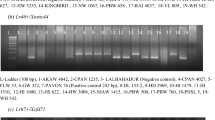Abstract
In order to determine the effects of bunt inoculation on frost resistance and winter hardiness in lines containing resistance genes, the bunt [Tilletia foetida (Wallroth) Liro, T. caries (DC.) Tulasne] susceptibility of wheat lines containing bunt resistance genesBt1 to Bt10 and the effect of the year on the degree of infection were studied over six years from 1991 to 1997 in an artificial inoculation nursery. Uninoculated and artificially inoculated wheat plants were tested for frost resistance in the phytotron in 1995 and in the field in boxes in three years from 1994/95 to 1996/97. The line withBt10 was very resistant, lines with Bt5, Bt6, Bt8 and Bt9 were resistant, the line with Bt4 was moderately resistant, those with Bt2 and Bt3 were moderately susceptible, the line with Bt1 was susceptible and the line with Bt7 was very susceptible to the local bunt population in Hungary. Bunt incidence also varied over years. The frost resistance of the Bt lines was generally lower after bunt inoculation than that of uninoculated plants. The increased frost kill in inoculated plants was not correlated with the extent of varietal susceptibility to bunt. Some lines with resistance, namely those with Bt5 (1.6% infection), Bt8 (0.6%) and Bt10 (0.0%), suffered significantly greater frost kill in the young plant stage as the result of bunt inoculation. By contrast, the Bt7line had excellent frost resistance and winter hardiness but suffered the greatest extent of bunt infection, whereas the Bt6 line had good frost resistance and good bunt resistance.
Similar content being viewed by others
References
Andrews, J.E., 1958. Controlled low temperature test of sprouted seeds as a measure of cold hardiness of winter wheat varieties. Can J Plant Sci 38: 1–17.
Babayants, L.T., 1988. Methods of breeding and evaluating wheat and barley varieties for resistance to diseases in CMEA member countries. (In Russian) Coordination Centre, Odessa/Prague.
Chauhan, R.S., A.K. Sood & B.M. Singh, 1994. Relative aggressiveness of new virulences of Tilletia foetida and T. caries on wheat cultivars. Indian Phytopathology 47: 232–235.
Chen, C. & L.V. Gusta, 1978. The role of water in cold hardiness of winter cereals. In: Plant Cold Hardiness and Freezing Stress. Acad Press, pp. 165–174.
De Noma, J.T., G.A. Taylor & H. Ferguson, 1989. Osmotic potential of winter wheat crowns for comparing cultivars varying in winterhardiness. Agron J 2: 159–163.
Gaudet, D.A. & B.J. Puchalski, 1989. Status of bunt resistance in western Canadian spring wheat and triticale. Can J Plant Sci 69: 797–804.
Gaudet, D.A., B.J. Puchalski, L.B. Kozub & G.B. Shaalje, 1993. Susceptibility and resistance in Canadian spring wheat cultivars to common bunt (Tilletia tritici and T. caries). Can J Plant Sci 73: 1217–1224.
Hayes, P.M., T. Blake & T.H.H. Chen, 1993. Quantitative trait loci on barley (Hordeum vulgare L.) chromosome 7 associated with components of winterhardiness. Genome 36: 66–71.
Hegyi, D., 1911. Data on the damage caused by smut fungi. I. Wheat bunt. Kísérletügyi Közlemények 14: 728–732.
Hoffmann, J.A. & R.J. Metzger, 1976. Current status of virulence genes and pathogenic races of the wheat bunt fungi in the Northwestern USA. Phythopathology 66: 657–660.
Johnson, L., 1992. Climate factors influencing attack of common bunt (Tilletia caries DC Tul.) in winter wheat in 1940–1988 in Sweden. Zeitschr für Pflanzenkrankh und Pflanzenschütz 99: 21–28.
Jonsson, J.O., 1992. Bunt resistance and seed dressing in an integrated cultivation system. Nordisk Jordbruksforskning 74: 39–46.
Keener, T.K., R.N. Stougaard & D.E. Maghre, 1995. Effect of winter wheat cultivars and difenoconazole seed treatment on dwarf bunt. Plant Disease 79: 601–604.
Kolar, S.D., P.M. Hayes, T.H.H. Chen & R.G. Linderman, 1991. Genotypic variation for cold tolerance in winter and facultative barley. Crop Sci 31: 1149–1152.
Kovács, A., 1955. Bunt resistance of wheat varieties in two years of experiments. Növénytermelés 4: 225–232.
Krivchenko, V.I., 1984. Resistance of Cereals to Smut Diseases (in Russian). Kolos, Moscow.
Kükedi, E., 1985. History, development and results of wheat seed dressing in Hungary with special regard to systemic fungicides. Bayer Növényvédelmi Híradó 2–4.
Law, C.N. & G. Jenkins, 1970. A genetic study of cold resistance in wheat. Genet Res Camb 15: 197–208.
Limin, A.E. & D.B. Fowler, 1989. The influence of cell size and chromosome dosage on cold-hardiness expression in the Triticeae. Genome 32: 667–671.
McIntosh, R.A., G.E. Hart, K.M. Devos, M.D. Gale & W.J. Rogers, 1998. Catalogue of gene symbols for wheat. Proc of the 9th Int Wheat Genet Symp, Vol. 5., pp. 143–144.
Moesz, G., 1950. Smut fungi in the Carpathian Basin. Egyetemi Könyvkiadó, Budapest.
Podhradszky, J., 1962. Wheat bunt and dwarf smut. Mezögazdasági Kiadó, Budapest.
Pomeroy, M.K., C.J. Andrews & G. Fedak, 1975. Cold hardiness and dehardening responses in winter wheat and winter barley. Can J Plant Sci 55: 529–535.
Steponkus, P.L., 1978. Cold hardiness and freezing inury of agronomic crops. Adv Agr 30: 51–89.
Sutka, J., 1981. Genetic studies of frost resistance. Theor Appl Genet 59: 145–152.
Szunics, Lu. & L. Szunics, 1990. Data on the bunt infection of wheat varieties. Növénytermelés 39: 297–304.
Thomashow, M.F., 1990. Molecular genetics of cold acclimation in higher plants. Adv in Genetics 28: 99–131.
Tischner, T., B. Köszegi & O. Veisz, 1997. Climatic programmes used in the Martonvásár phytotron most frequently in recent years. Acta Agron Hung 45: 85–104.
Ubrizsy, G., 1965. Plant Pathology. 1–2. Akadémiai Kiadó, Budapest, pp. 443.
Veisz, O. & J. Sutka, 1989. The relationships of hardening period and the expression of frost resistance in chromosome substitution lines of wheat. Euphytica 43: 41–45.
Veisz, O., Lu. Szunics & L. Szunics, 1997. Reduction in the frost resistance and winter hardiness of winter wheat varieties as the result of bunt infection. Növénytermelés 46: 115–123.
Zhivotkov, L.A., 1989. Wheat (in Russian). Urozhay, Kiev.
Author information
Authors and Affiliations
Rights and permissions
About this article
Cite this article
Veisz, O., Szunics, L. & Szunics, L. Effect of common bunt on the frost resistance and winter hardiness of wheat (Triticum aestivum L.) lines containing Bt genes. Euphytica 114, 159–164 (2000). https://doi.org/10.1023/A:1003940808041
Issue Date:
DOI: https://doi.org/10.1023/A:1003940808041




